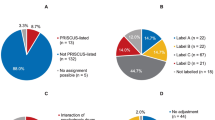Abstract
Background Elderly patients in long-term care units are frailer than their community-dwelling peers and may be more at risk from toxic side-effects of anticonvulsant medication at standard doses.
Aim To examine the prescribing of anticonvulsants to patients in elderly care units.
Methods Drug prescription sheets and case notes were reviewed. Serum anticonvulsant concentration, renal and liver profiles and albumin level were measured.
Results Anticonvulsants were prescribed to twice as many male as female patients (32 vs 14%; p<0.03) and to 33% of those younger than 80 years of age versus 10% of those aged 80 years or older (p<0.0002). No patient had significant hypoalbuminaemia and routine measurement of serum anticonvulsant concentration did not indicate an alteration of dosage.
Conclusions Anticonvulsants appear to be well tolerated in these patients. The younger age of those receiving anticonvulsants is inadequately explained by the characteristics of the patient cohort and may reflect a shift towards a younger age in patients requiring anticonvulsants due to increased mortality in this group.
Similar content being viewed by others
References
Cloyd JC. Clinical pharmacology of antiepileptic drugs in the elderly: practical applications.Consultant Pharmacist 1995; 10: 9–15.
Rowan AJ. Reflections on the treatment of seizures in the elderly population.N€logy 1998; 51 (Suppl 4): S28–33.
Koyama H. Effect of glycosylation on carbemazepine-serum protein binding in humans.J Clin Pharmacol 1997; 37 (11): 1048–55.
Wilmore LJ. Management of epilepsy in the elderly.Epilepsia1996; 37 (Suppl 6): S23–33.
Lenn NJ, Robertson M. Clinical utility of unbound antiepileptic drug blood levels in the management of epilepsy.N€logy 1992; 42: 988–90.
Faught E. Epidemiology and drug treatment of epilepsy in elderly people.Drugs Aging 1999; 15: 255–69.
Hauser WA, Annegers JF, Kirland LT. Prevalence of epilepsy in Rochester, Minnesota: 1940-1980.Epilepsia 1991; 32: 429–45.
Lackner TE, Cloyd JC, Thomas LW, Leppik IE. Antiepileptic drug use in nursing home residents: effect of age, gender and comedication on patterns of use.Epilepsia 1998; 39: 1083–7.
Timmons S, Sweeney B, Hyland M, O Mahony D, Twomey C. New onset seizures in the elderly: aetiology and prognosis.IMJ 2002; 95: 47–9.
Cloyd JC, Lackner TE. Antiepileptic drugs in the elderly: pharmacoepidemiology and pharmacokinetics.Arch Family Med 1994; 7: 589–98.
Grandison M, Boudinot F. Age-related changes in protein binding of drugs: implication for therapy.Clin Pharmacokinet 2000; 38 (3): 271–90.
Author information
Authors and Affiliations
Corresponding author
Rights and permissions
About this article
Cite this article
Timmons, S., McCarthy, F., Duggan, J. et al. Anticonvulsant use in elderly patients in long-term care units. Ir J Med Sci 172, 66–68 (2003). https://doi.org/10.1007/BF02915249
Issue Date:
DOI: https://doi.org/10.1007/BF02915249




